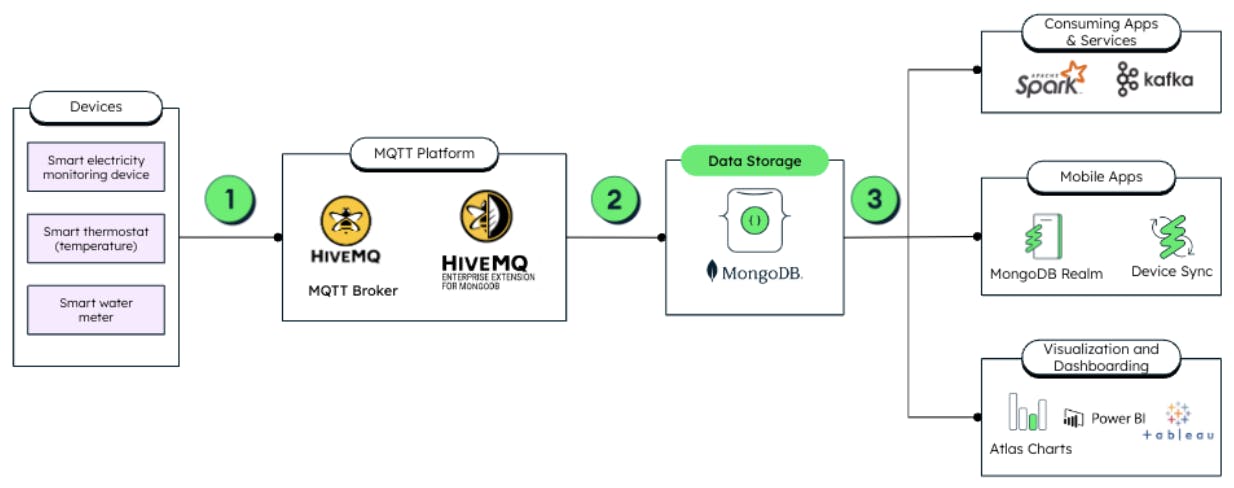Real-Time Energy Monitoring for Smart Buildings with MongoDB and HiveMQ
The Internet of Things (IoT) has ushered in a new era of energy efficiency, enabling the deployment of energy-efficient sensors for energy conservation and resource utilization. With over 1.5 billion connected IoT devices already installed in commercial smart buildings in 2022 and a projected surge to 3.25 billion devices by 2028, the volume of data generated is staggering. To put it in perspective, an average home in 2020 would generate approximately 4.7 terabytes of data annually. However, managing and harnessing this immense amount of real-time streaming data poses a significant challenge for developers. In smart buildings, where a multitude of IoT sensors continuously gather event streaming data, developers often grapple with integrating disparate technologies and investing significant time into data streaming integration.
In this blog, we present a simple yet powerful solution to this challenge. We will demonstrate how you can effortlessly move IoT data using standard protocols such as MQTT to MongoDB Atlas using the HiveMQ Enterprise Extension for MongoDB. By optimizing smart buildings with real-time energy monitoring through the seamless integration of MongoDB and HiveMQ, we unlock the potential for efficient energy management and a sustainable future.
Let’s get started!
Dream team: HiveMQ + MongoDB
In a world where energy conservation and efficient resource utilization are essential, let’s go through Figure 1 and see how simple it is to use MongoDB, HiveMQ’s MQTT broker, and the Enterprise Extension for MongoDB to enable real-time energy monitoring for smart building.

Step 1: Data transmission
Using MQTT-based IoT devices deployed throughout the building, electricity consumption, temperature, and occupancy data is collected and sent to the HiveMQ MQTT broker. The MQTT broker acts as a central hub, efficiently and securely handling the communication between devices and backend systems. The HiveMQ MQTT broker also ensures reliable message delivery. It also provides MQTT-specific features like quality of service, session management, and topic-based message routing.
Step 2: Data ingestion
The HiveMQ MongoDB extension seamlessly integrates with MongoDB, allowing for persistent storage of the MQTT data in a highly scalable and flexible manner. The fully customizable templating system allows MQTT data to be stored according to the building’s specific operational requirements. MongoDB's document-based model accommodates the varying data formats and structures generated by different IoT devices.
Step 3: Data visualization and analytics
Once the MQTT data is securely stored in MongoDB, using its powerful in-app analytics, building managers can gain deep insights into energy consumption patterns, identify anomalies, and optimize energy usage. By leveraging MongoDB's rich query support and aggregation framework, building managers can make data-driven decisions promptly, reducing costs and enhancing sustainability. In cases where data needs to be exported to an ML/AI engine, MongoDB Spark and Kafka connectors can be used. Users of MongoDB Atlas can leverage Atlas Device Sync and Realm to send real-time alerts and messages to mobile devices. Data can be visualized using MongoDB Atlas Charts or through a third-party Business Intelligence (BI) tool connected via MongoDB BI connector or Atlas SQL interface.
Conclusion
By seamlessly integrating HiveMQ's MQTT broker with MongoDB, developers can efficiently handle data transmission, ingestion, and storage. This integration enables building managers to gain valuable insights into energy consumption patterns, make data-driven decisions, and optimize energy usage.
To learn more about MongoDB’s role in IoT, please visit our IoT webpage. You can also try the HiveMQ platform now with the Enterprise Extension for MongoDB for free.
Thank you Ainhoa Múgica for her contributions to this blog.